|
UPDATE!
Bowen
Classic Arms' new web site has gone online - it's an
excellent redesign, and I extend my compliments to Hamilton and
his web designers. The newly-redesigned site now features Bearcat
packages, from a basic action tune package to Bowen's
excellent "Perfected Bearcat". I cannot recommend
Bowen's work highly enough.
Boge
Quinn -
May 19th, 2011
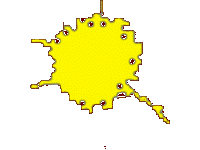  
Anyone who knows me well knows of my fondness
for the Ruger Bearcat.
Introduced in late 1958 and reminiscent of the 1858 Remington
New Police revolver, the little .22 immediately struck a chord
with the gun buying public. A quality-made, lightweight, tough,
accurate, cowboy-style kit gun at an introductory price of
$49.50 (later reduced to $39.50 because favorable sales allowed
them to be produced at a lower per-unit cost) – how could the
Bearcat miss?
The Bearcat is my favorite .22 revolver for a
very simple reason: I believe the Bearcat to be the most
perfectly-sized .22 sixgun ever made. For a kit gun, why carry a
heavy .22 when the 17-ounce Bearcat (or the later 24-ounce Super
Bearcat and New Bearcat)
is available? This is not to state that there is no need for
larger .22s – I own many Bearcats, but I also own many larger
and heavier .22 revolvers, from Ruger’s excellent Single-Sixes
to Smith & Wesson’s equally-excellent K-frame .22s
and J-frame kit guns, to the
wonderful old High
Standard Sentinels. Each has its place, from small-game
hunting to plinking, even to personal protection, and each has a
job that it does better than the rest. S&W’s kit guns, in
particular, are to the double-action .22 what the Bearcat is to
the single-action: absolutely the best. Still, I prefer
single-actions, so while I love my S&Ws, the Bearcat reigns
supreme. This is why you can never own too many .22 sixguns!
As my brother Jeff likes to say, any handgun is
an exercise in compromise, and the Bearcat is no exception.
Still, to me, the Bearcat is the .22 I most want to pack around
when I am in the woods, and it’s the one I reach for when I
just want to have some fun burning up some .22 ammo. The weight
is perfect, the size is perfect, and the balance is perfect.
I’ve heard large-handed shooters complain that the Bearcat’s
grip is just too small for them, but the little plow-handle grip
nestles into my large hand very comfortably, and my pinky curls
underneath in just the right manner.
The above-mentioned revolvers, and others as
well, are the favorite .22s of millions of
Americans, and it is hard to argue with them. Their larger grip
frames feel better to many; the added weight helps with the only
kind of “gun control” we should ever have to discuss; the
longer barrels available yield greater velocity; and perhaps
most importantly, the sights are vastly better than the sights
on the little Bearcat, and are often fully adjustable for
windage and elevation. This makes these revolvers easier to
shoot accurately, and the adjustable sights allow them the
ability to shoot a wide variety of loads to the sights.
Admittedly, sights are one area in which the Bearcat falls
short: the rear sight is the familiar single-action type groove
in the top of the frame, and the front sight is the
equally-familiar rounded blade which can be hard to pick-up in
all but perfect lighting conditions, especially to aging eyes
like mine.
In short, the Ruger Bearcat may not be all
things to all people, not even to myself, but it is still my favorite.
Hamilton Bowen, I can state without fear
of too much argument, is our greatest living custom revolver
maker. Building on the pioneering work of such legendary men as Croft
and Sedgley, Hamilton Bowen has elevated the custom
revolver beyond its utilitarian purposes into the realm of art. He
literally wrote the book on custom revolvers. We are
truly living in a Golden Age of custom guns, and this Age was
largely ushered in by the work of Hamilton Bowen. There are many
custom revolver makers today who do amazing work, but there is
something about a Bowen gun that no other gun possesses; an
artistry, a perfect geometric meeting of angles and curves, even
a “soul”.
I was introduced to the work of Hamilton Bowen
as a teenager by the excellent writings of the man whom I
consider to be the Dean of modern gun-writers and heir to the
mantle of such iconic men as Elmer Keith and Charles
“Skeeter” Skelton: John Taffin. Taffin often
wrote of Bowen’s work, and his descriptive prose was almost as
breathtaking as the accompanying pictures of Bowen’s guns,
describing the beauty of the case colors, the artistry of the
scalloped loading gate, the perfect symmetry of the Damascus
octagonal barrel, and the flawless craftsmanship. Taffin is also
an excellent technician and shooter, and his extensive loading
work made it clear that Bowen’s guns were not only beautiful,
but also powerful and functional tools, able to cleanly and
surely take even the largest and most dangerous game. Taffin
lived in a world of which I could only dream; a world populated
by exotic game animals, adventure, and the finest guns ever
made; and his words made that world real to my impressionable
young mind. I am quite sure that Taffin’s words, regarding
Bowen’s work as well as many other subjects, made much more of
an impact on me as a young man than he can possibly realize, and
owning a Bowen gun became one of my fondest, and surely
unattainable, dreams.
It is a testament to the depth of God’s
blessings that I can now call both Hamilton Bowen and John
Taffin my friends, and my brother Shootists.
It is a further testament to His blessings that I now own
multiple Bowen guns, one of which is the subject of this
article: a one-of-a-kind Bowen Classic Arms Custom Ruger
Bearcat.
The story of my Bowen Bearcat started when I
acquired a shooter-grade Old Model Bearcat, made in late 1969,
at a very reasonable price. I had considered having a custom
Bearcat made for a long time, and I knew that Bowen was the man
I wanted to do the work. My idea of what I wanted was this:
rechamber to .22 Magnum, put on a S&W J-frame type rear
sight (which would also require a custom front sight), and
refinish. The only problem was, Hamilton didn’t want to do it!
Seems he had fiddled with a Bearcat or two many years ago, and
found them to be too inconsistent in their tolerances to be
feasible as a catalog item. After some wheedling and outright
begging, he agreed to take on the project as long as I kept it a
secret. He didn’t want word getting out that he was working on
a Bearcat for me, so I agreed to keep it under my hat and sent
him the Bearcat.
A problem that Hamilton encountered early on lay
with the lightweight aluminum alloy frame, and the J-frame
sight’s tang screw threads. Typically, these screws go
straight into the top strap, and they are quite small and
fine-threaded. The sight works basically by becoming its own
leaf-type spring – it is made to always be under some tension
so as to provide elevation detenting, and this tension is offset
by the screws. As thin and soft as the aluminum-framed
Bearcat’s top strap is, Hamilton was concerned that the
threads would strip the first time I tried to tighten the
screws. At first glance, Hamilton thought he might try some sort
of threaded sleeve for the sight screw but,
unfortunately, the screw hole would need to fall into the barrel
thread section of the receiver, and Hamilton was not sure this
would be a good arrangement. His idea was to try it on a
steel-framed Super Bearcat , but I really wanted to use the
lighter-weight aluminum-framed gun, so I suggested the screw
might be moved back until it is no longer over the barrel
threads. Hamilton’s idea was to use a sort-of helicoil
arrangement, where a threaded sleeve is installed with fine
threads inside and coarser threads outside. He thought it would
be worth a try – as he said, “All we can do is ruin it.”
The
final solution for the rear sight problem came about because
Hamilton was not happy with the screw location on the J-frame
sights, and my idea of moving the hole back from the barrel
threads would be too labor-intensive to be practical. Hamilton
decided that a smaller pre-War style rear sight would be better,
and remembered that David Clements makes just such a
sight. Hamilton procured two from Clements, which proved to be
prescient of him because one was ruined during the process –
it seems the Bearcat’s frame was quite crooked, and a second
sight had to be used in order to get the screws in the right
place. Once the frame and the top strap contour were
straightened out, Hamilton was able to install the pre-War style
rear sight without too much trouble, and as you can see from the
photos, the sight turned out much nicer than a J-frame sight –
just as Hamilton surmised. That Clements sights is the
nicest-looking adjustable sight I have ever seen on a Bearcat
– it really looks like it belongs there. As a finishing touch,
Hamilton contoured the front of the sight to match the shape of
the front of the Bearcat’s frame – truly a classy and
functional sight.
The
custom front sight Hamilton fabricated is perfect – a small
custom base with a pinned in, serrated blade, offering a crisp
and non-reflective sight picture while maintaining an
unobtrusive appearance. Hamilton was also nice enough to send an
extra unshaped blade, just in case I found his blade less than
perfect; it resides in its Ziploc bag, where I suspect it will
remain for the foreseeable future.
While
Hamilton was sorting out the frame and sight issues, I got the
idea that a .22 Long Rifle / .22 Magnum convertible Bearcat
would be neat, rather than just rechambering for .22 Magnum.
Both Hamilton and I thought that finding a proper spare cylinder
might be difficult, but my "Yooper" pal Lloyd Smale found a
nice Old Model cylinder for me in a Michigan pawnshop for only
$20, and we were in business. Hamilton found that the second
(pawnshop) cylinder timed-up a bit better than the original’s,
so he used that cylinder for the .22 Magnum (as he put it,
“since I'd rather have a LR go off out of battery than a
Mag”). Another problem was encountered when exploring the
firing pin layout. The trouble with the Magnum cylinder was the
firing pin location. The problem was, the .22 Magnum’s rim
diameter is larger so the firing pin was hitting too near the
center of the cartridge to set off the priming compound along
the rim of the case. What Hamilton ended up doing was making up
a firing pin out of a Single-Six part and contouring the nose to
obtain reliable ignition on both cylinders. He also polished off the Magnum cylinder’s Bearcat roll mark so it
would be easy to distinguish the two. This also gave the gun a
very distinctive look with the Magnum cylinder installed.
Once
Hamilton got the problems associated with the dual cylinders
worked out, he turned his attention to the worn lockwork. He had
to work some of his magic on the original lock parts, but he was
able to save them and restore them to crisp as-new function. He
had to do some work to eliminate cylinder end shake, and he also
fit custom endfloat / headspace bushings on each cylinder. A
fine time & tune job completed the action repairs, and the
Bearcat now locks-up better than any new Bearcat I have ever
handled. Timing is perfect, as evidenced by the fact that, to
this day, there is no sign of a turn ring on either cylinder.
The only
modification to the original barrel that Hamilton made was to
add the all-important “BOWEN CLASSIC ARMS CORPORATION”
roll mark to the top of the barrel. I was very pleased by this,
as the barrel now sports Hamilton’s mark as well as the
original “STURM RUGER & CO. SOUTHPORT, CONN.”
roll mark, along with the Ruger Eagle mark, on the side of the
barrel (being an Old Model Bearcat, the barrel does not feature
what Hamilton calls “a little light reading from Ruger’s
legal department”). Some Ruger experts had told me that the
groove diameter of the Bearcat would not work for the .22 Magnum
cartridge, but not being an expert myself, I decided to leave
that up to Hamilton. The Bearcat proved to be up to this
challenge for which it was not designed, as it shoots both .22
Magnum and .22 Long Rifle cartridges with very satisfying
accuracy. Hamilton had sighted the gun in for .22 Magnum
ammunition; his sight adjustments worked perfectly for my eyes
as well, and I found that no further sight adjustments were
required. Even with the .22 Long Rifle cylinder installed, the
gun shot very close to the sights as received using my favorite
plinking ammo, Federal’s bulk pack.
After
all problems were straightened-out and the gun was shooting as
it should, Hamilton turned to the cosmetic aspects of the
project. As I have already mentioned, the Bearcat started out as
a “shooter-grade”, which is a nice way of saying it was
pretty beaten-up. Not only were the lock parts badly worn, but
there was significant pitting evident on the frame, and quite a
bit of finish loss throughout. A close inspection of the
pictures will show a slight amount of pitting still evident on
the right side of the aluminum frame, just below the hammer;
this is all that remains of the roughness of the Bearcat in its
original condition, and Hamilton did an excellent job of
restoring the gun’s appearance. I could have saved him a lot
of work if I had sent him a Bearcat in better condition to begin
with, but as a lover of those old Bearcats I just couldn’t
bring myself to modify one of my collector-grade guns; I trust
Hamilton has forgiven me by now for all the extra work.
The
final step was refinishing and reassembling the gun, and here is
where Hamilton again offered some sage advice. He refinished all
the steel parts in-house, and recommended I let him send the
aluminum parts to W.E. Birdsong for their “Black-T”
Teflon finish. He told me that Black-T is a very tough and
cosmetically pleasing finish, and I of course accepted his
recommendation. I am glad I did – as you can see from the
pictures, the Black-T finish on the frame and trigger guard is a
beautiful matte black, and offers a nice contrast to the
polished blued steel of the barrel and cylinder.
When I
received the gun (nearly four years ago as of this update), I was
absolutely ecstatic. I finally owned a Bowen gun, and the most
beautiful and practical Bearcat I have ever seen. The entire
cost of the gun, including all the custom work and the original
gun, was not cheap, but it was quite reasonable for all the work
involved; it was quite amusing to
Jeff that I wrapped up that much money in a Bearcat, but he
underestimated my love for Bearcats and my longing for a custom
Bowen gun. I considered it money well spent, because I now owned
a Bowen that was unlike any other had ever been, or would ever
be.
To
summarize the work that Hamilton did to my Bearcat:
-
Modify
/ machine top strap for Clements Pre-War S&W style rear
sight, including steel thread plugs
-
Install
Clements Pre-War S&W style rear sight
-
Fabricate
custom front sight base / silver solder on pin-in serrated
blade
-
Repair
action / time & tune
-
Fit
custom endfloat / headspace bushings on both cylinders
-
Rechamber
one cylinder to .22 Magnum & remove factory roll mark
-
Install
custom modified firing pin / test fire for function and
sight-in
-
Polish
& blue steel parts
-
Prep
aluminum parts and send to W.E. Birdsong for Black-T finish
Some
time after receiving the Bearcat, I was still basking in the
magnificence of the little gun, and I was just dying to let some
of my friends take a look at it. So I asked Hamilton if I could
break my silence and tell some folks about it, and he said that
would be fine but that he did not want me to write a feature
article for Gunblast because he did not plan to do any more and
didn’t want to have to explain why to a multitude of Gunblast
readers. Hamilton asked me to make it clear to everyone that he
would not be doing any more work on Bearcats, as he assured me
that he easily had twice as much work in my gun than his billing
indicated. As he wrote to me, “You might tell anybody that
wants to know that this was a one-off experimental piece and
that we do not, at this writing (October 1, 2007), plan to offer
Bearcat services as a catalog item.”
I showed
the Bearcat to some of my Shootist friends, and posted some
pictures of it to some Boards that I frequent, including the
Ruger Forum (www.rugerforum.com).
Shortly thereafter I received an email from Sack Peterson,
a grip maker who also frequents the Ruger Forum and shares my
love of Bearcats. Peterson specializes in American Elk Stag
grips for Ruger revolvers, and while I had been impressed with
the pictures I had seen, I had never handled any of his grips.
Sack wanted to tell me how impressed he was by my Bearcat, and
asked if he could send me a set of American Elk grips for it. I
was only too happy to oblige, so very shortly I received a
beautiful set of Elk stags that really sets off my Bowen
Bearcat. These are the nicest Elk stags I have ever seen. The color and the amount of
“bark” are perfect, and there is practically zero pith.
Peterson does an excellent job of matching the figure and color
of each panel, and the fit is excellent. Another thing I really
like about Peterson’s grips is that they are profiled very
much like the original grips. Often you see stag grips that are
far too thick, which alters the handling qualities of the gun;
Peterson’s grips are profiled just like the original Bearcat
grips, so the excellent feel of the grip’s shape in the hand
is maintained, while the “bark” of the grips offer a much
better and more positive feel than the original smooth walnut
grips. These are some of the nicest stag grips I have ever seen,
and I highly recommend Sack’s work – in fact, I have since
bought some more grips from him, and I can offer no higher
praise than that.
When the
time came to order some leather for my Bowen Bearcat, I did what
I often do: I contacted Rob Leahy at Simply Rugged
Holsters. Rob’s holsters are just what the name suggests:
simple and rugged in design and construction, but still
beautiful and supremely functional. He makes holsters of several designs, but his most
popular is the classic pancake design. Rob’s pancake holsters
offer multiple slots so the angle of the holster can be
adjusted. My personal favorite way to carry most field handguns
is an across-the-chest holster rig, and Rob offers the slickest
chest rig I have ever seen – the Chesty Puller system.
Using simple adapter straps, the Chesty Puller rig allows any of
Rob’s (or any other maker’s) pancake holsters to easily and
quickly adapt to an across-the-chest rig. Rob even offers
adapter straps at a very reasonable price that will allow
virtually any belt holster of virtually any design to be used
with the Chesty Puller system. It’s a really nifty, versatile,
and cost-effective system, and is much more comfortable than
standard belt carry for “full figured” shooters like me. Rob
can custom make holsters for just about anything, his prices are
reasonable, and he’s a great guy to boot. I highly recommend
you try some of his leather.
And now
for some really good news: as I mentioned above, Hamilton Bowen finally allowed me to show the Bearcat to
some folks, with the caveat that I was not to write a Gunblast
article featuring the Bearcat. So why now am I writing this
article? A few weeks ago Hamilton emailed me that he had been
thinking about how nicely my Bearcat turned out, and that he had
reconsidered offering Bearcat services as a catalog item. He
said he was considering offering a package for the Bearcat in
the near future. Bowen’s Bearcat package will only be offered
on the New Bearcat, both because they are easier to obtain and
because they are constructed with better consistency in many
cases. He’s not sure yet exactly what the catalog Bearcat
package will include, but will probably consist mostly of tuning
and new sights with shortened barrels as an option. He says that
any package they offer will feature the excellent Pre-War
S&W style rear sight. As Hamilton says, “They are the only
reason to work on these guns as far as I am concerned, and will
be the main part of any package we do on the Bearcats. The
package will also include a simple front sight blade/base.
Cutting barrels would probably be an option but might make for a
more compact gun where indicated.” At Hamilton’s suggestion
(resulting from a series of not-so-subtle hints from me), I
immediately sent him a New Bearcat as a prototype for Bowen
Classic Arms’ "Perfected Bearcat" package, and I await the results
with great anticipation. Look for a Gunblast article on the
Bowen Bearcat Package as soon as it becomes available.
In the meantime, be sure to let Hamilton know of your interest
in a Bowen Bearcat - you can call him at (865) 984-3583.
The more interest he sees, the more likely he is to catalog the
Bearcat package. Tell him Boge says "howdy".
With the
Bowen Bearcat, Hamilton Bowen has taken one of the finest
sixguns ever made and elevated it to absolute perfection. Best
of all, soon these fine little sixguns may be available to any shooter who desires the finest .22 available, from the
finest custom revolversmith of our time.
Visit www.bowenclassicarms.com
to view and order the finest custom revolvers available.
Check
out Sack Peterson’s American El Stag grips at www.sackpeterson.com.
For Rob
Leahy’s Simply Rugged holsters, go to www.simplyrugged.com.
Boge
Quinn
  
Got something to say about this article? Want to agree (or
disagree) with it? Click the following link to go to the GUNBlast Feedback Page.
|
|
Click pictures for a larger version.
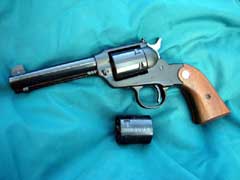
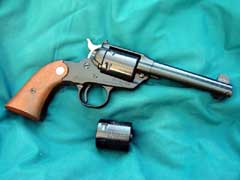
Bowen Classic Arms custom .22 Magnum / .22 Long Rifle
Ruger Bearcat, shown with .22 Magnum cylinder installed.
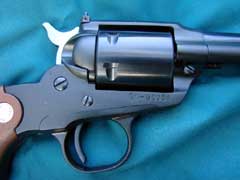
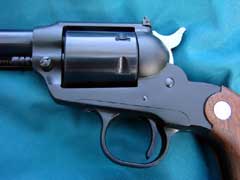
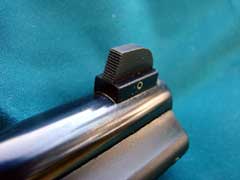
Front sight is a custom-fabricated base with pinned-in
blade.
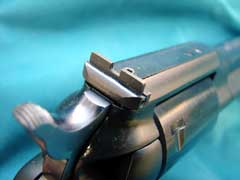
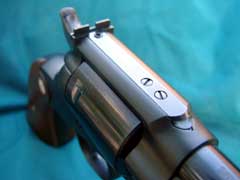
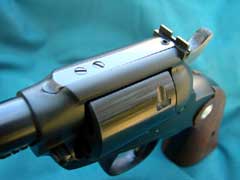
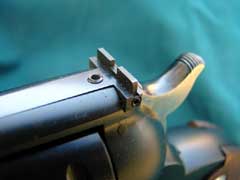
Rear sight is a Pre-War S&W style by David Clements,
custom contoured and fit to the Bearcat frame.
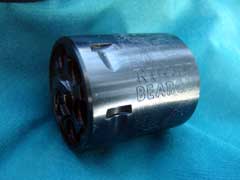
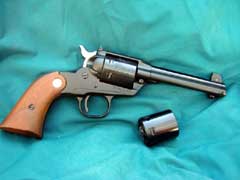
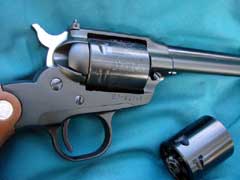
Bearcat with .22 Long Rifle cylinder installed.
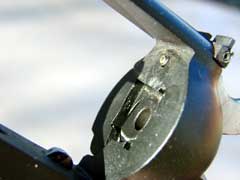
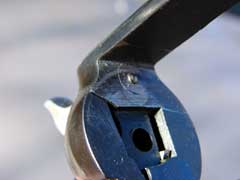
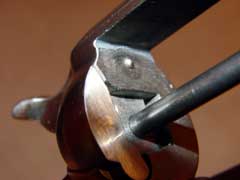
Firing pin comparison shows how Hamilton Bowen solved
the problem of striking the rims of the differently-sized
cases. Bowen Bearcat (top) has a custom-fabricated firing pin
of a larger, truncated cone shape. Old Model Super Bearcat
(center) has a conventional rounded shape. New
Model Stainless Bearcat (bottom) has a shape similar
to Bowen's, but smaller in size.
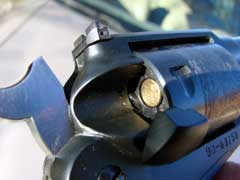
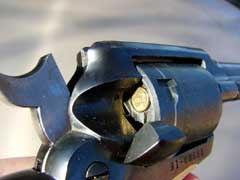
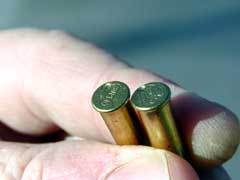
These pictures show the difference in firing pin shape
on the case head. Bowen Bearcat (top) has a noticeably larger
area than the Old Model Super Bearcat (center). Bottom picture
shows the firing pin strike of the Bowen Bearcat at left,
compared to that of the Old Model Super Bearcat at right.
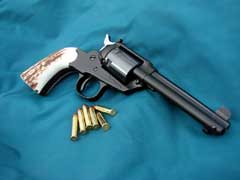
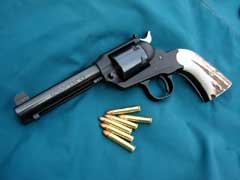
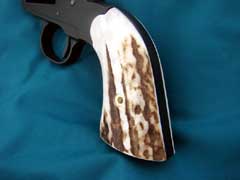
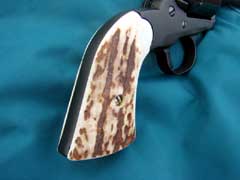
Sack Peterson American Elk Stag grips really dress up
the Bowen Bearcat, adding a look of distinction and improving
handling.
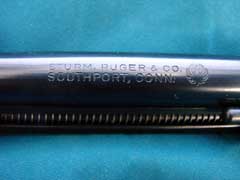
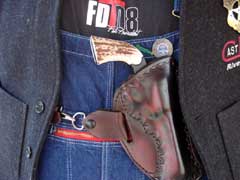
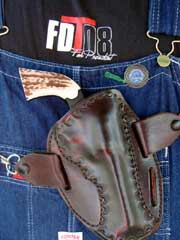
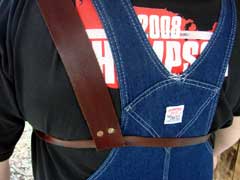
Simply Rugged pancake holster adapted for the Chesty
Puller system is a comfortable and secure way to carry the
Bearcat afield.
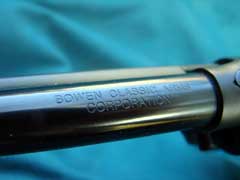
|
![]()